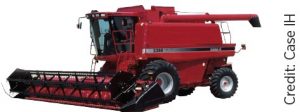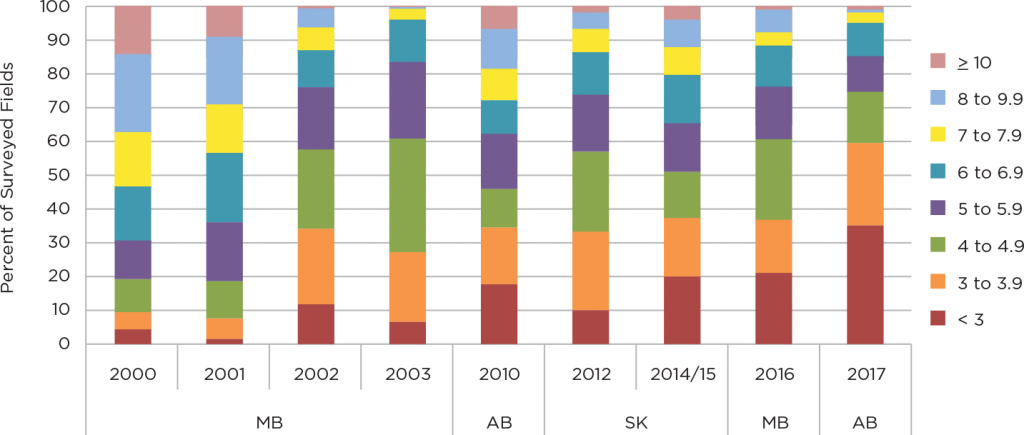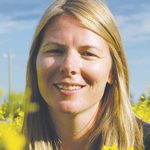Agronomy Insights
Top 10 weeds in canola
Julia Leeson, weed monitoring biologist with Agriculture and Agri-Food Canada (AAFC) in Saskatoon, lists the top 10 weeds in canola based on results from the latest Prairie-wide weed surveys, conducted from 2014-17.
For the survey, quarter sections were selected by random sample and owners called for permission to check the fields. Surveys are done after in-crop weed control. Surveyors count weeds in 20 quadrats (half a metre by half a metre squares) in each field, taking care to avoid field edges and abnormal areas (drowned areas, bluffs, etc.) Weeds are noted for frequency (per cent of fields with that weed), field uniformity (per cent of quadrats in a field that have that weed), field density (number of weeds per square metre) and relative abundance (which weeds are the most common).
Here are the top 10 most common weeds in canola crops across the Prairies:
- Wild buckwheat. Found in 56.5 per cent of fields, wild buckwheat had the highest frequency by far. Wild buckwheat has been in the top four for decades, but is number one for the first time.
- Wild oats. This familiar weed has been in top three for decades, but overall numbers are going down.
- Green foxtail. This weed was found in 25 per cent of fields, but among those fields, it had the highest average density of any other weed in the top 10.
- Volunteer wheat. Wheat had never cracked the top 10, until now, possibly reflecting typical rotations where wheat precedes canola.
- Cleavers. More accurately called ‘false cleavers’, this weed keeps moving up the list. Perhaps better in-crop control in canola, with the availability of quinclorac, will help.
- Chickweed. This was found in only 14 per cent of fields, but within those fields it can be very heavy in patches. In one field, surveyors recorded an average density of 1,073 per square metre.
- Volunteer canola. This made a big jump from spot 32 in the 2000s survey.
- Spiny annual sow thistle. This is another weed that, like chickweed, can be very heavy in small patches. In one field, surveyors recorded an average density of 545 per square metre. Spiny annual sow thistle made the top 10 for the first time, up from spot 20 in the 2000s survey and 33 in the previous two surveys.
- Lamb’s-quarters. This was the number two weed in the 1980s, and frequency has been going down ever since.
- Canada thistle. Frequency is down from the previous survey. It just slightly edged out shepherd’s purse (which is also going down) and dandelion.
While not in the top 10, these weeds are moving up the list: Barnyard grass (13), cudweed (15), plantain (18), round-leaved mallow (21), northern willowherb (24) and foxtail barley (27). Farms noticing an increase in these weeds may want to check weed management practices to see how they can be controlled.
Combine college
Whether you are running brand new equipment, equipment that has years of experience or are an agronomist working with farmers, you will learn tips to help maximize net return during harvest. Every major combine type will be there along with qualified technicians.
March 20 in Brandon, Manitoba | Keystone Centre
canolagrowers.com/upcoming-events/combine-college
July 10 in Lethbridge, Alberta | Enmax Centre
albertacanola.com/combinecollege
The risk with low plant populations
Economic analysis suggests that a canola stand of five to eight plants per square foot is the most profitable based on yield potential and input costs. But while surveying for weeds, the team led by AAFC weed monitoring biologist Julia Leeson, also surveyed canola stand densities and found that more than half of canola fields are below that threshold.
Here are the latest canola results for each Prairie province:
2017 in Alberta: This survey had the lowest canola plant-density recordings, with fewer than five per square foot in 75 per cent of fields. (One third of fields surveyed had fewer than three canola plants per square foot.)
2016 in Manitoba: Sixty per cent of fields had fewer than five plants per square foot. (One in five had fewer than three canola plants per square foot.)
2014-15 in Saskatchewan: Fifty per cent of fields had fewer than five plants per square foot. (One in five had fewer than three canola plants per square foot.)
Uniformity a concern with low counts
Low counts that are uniform can yield quite well in good growing conditions, but one of the risks is that low plant counts combine with poor uniformity across a field. That will mean large patches where fields are not producing canola at an optimal level, Leeson says. Her surveys showed that in fields with an average density of three to 3.9 plants per square foot, over 40 per cent of the area in those fields had areas with an average below three. Even in fields with an average density over four plants per square foot, 20 per cent of quadrats had fewer than three plants per square foot.
In another canola harvest loss survey of 206 fields from earlier this decade, University of Manitoba professor and researcher Rob Gulden recorded canola stubble density at harvest. Stubble density for the fields ranged from 20 to 120 plants per square metre (or about two to 12 per square foot). Interestingly, the amount of variation, expressed as a percent relative to the stand density, was basically the same for all stand densities. Fields with low plant counts did have variability, but it wasn’t better or worse than fields with high counts. However, what this stat does not tell us is that with low plant counts, those thinnest parts of the field could have much lower yields. Thinner areas within already thin stands (areas with less than one plant per square foot in fields with an average of two plants, for example) do not have the same capacity to compensate for lost yield potential the way that thin areas within thick stands can (areas with less than three plants per square foot in fields with an average of six plants).
Low plant populations and maturity
Canola plants with lots of space to grow will get bigger and branchier. That is why yields can still be fairly good with low plant populations. But those big plants with lots of side branches will take longer to mature, and quality of harvested seeds in those side branches is at risk of higher green if frost hits them before the green has cleared.
A Saskatchewan study called, “Response of canola to low plant populations and evaluation of reseeding options,” by Anne Kirk et al, compared various plant stands from field trials at locations across the province over three years, 2010-12.
The study confirmed that thin stands flower longer and take longer to mature. When site years were combined, the study found a reduction in plant density from 70 to 21 plants per square metre (roughly seven to two per square foot) resulted in a six-day increase in flowering period and a three-day increase in days to maturity. The difference in days to maturity between seven plants per square foot and 0.5 per square foot is nine days, showing how thin patches in a non-uniform field can be unmanageably delayed.
Average Canola Density (plants per square foot)

Stand establishment data at the Research Hub
The Canola Research Hub at canolaresearch.ca will help you navigate the results from recent research projects, including those on canola plant establishment. In the “Research database” box, click on “What are some of the factors that impact canola emergence,” then use the filters to pull out the data that applies most to your farm situation. You can filter the tables in this query by province, year, drill type or other factors. To read more about the studies from which the tables were extracted, select the project in the ‘Related Research Summaries’ section at the bottom of the page. The same database also has customizable queries on seed-placed fertilizer and flea beetle management.
Sign up for canola watch
Canola Watch is a timely agronomy email from the Canola Council of Canada agronomy team. It provides field observations and agronomy tips throughout the growing season. To receive this valuable tool, funded by levy dollars, go to canolawatch.org/signup.
Get to know your CCC Agronomy Team
Find the whole team at canolawatch.org/contact-us.
 Autumn Barnes
Autumn Barnes
Agronomy Specialist, Southwest Prairies
Contact: 403-360-0206 and
barnesa@canolacouncil.org
Twitter: @AutumnCCC
Specialty: Stand establishment
 Warren Ward
Warren Ward
Agronomy specialist, Eastern Saskatchewan
Contact: 306-621-0630 and
wardw@canolacouncil.org
Twitter: @WardCCC
Specialty: Fertility
 Clint Jurke
Clint Jurke
Agronomy Director, Oversees the team and covers the Alberta-Saskatchewan border territory
Contact: 306-821-2935 and
jurkec@canolacouncil.org
Twitter: @JurkeCCC





